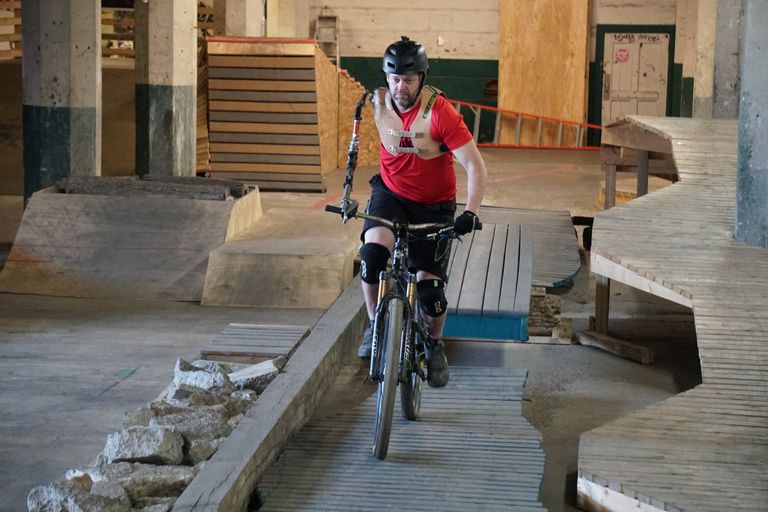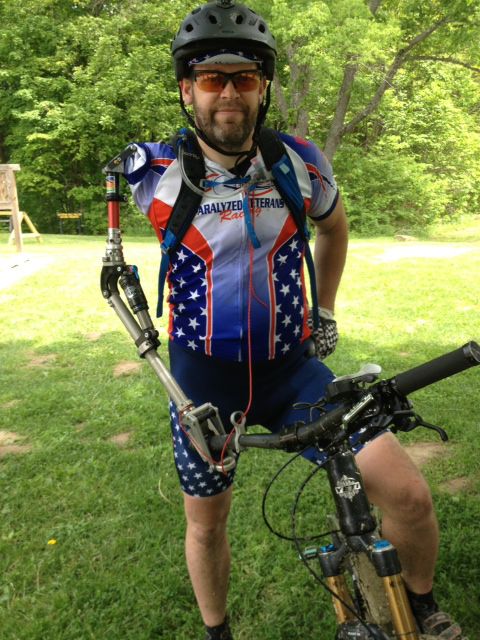
I’m not an inspiration, I’m a mountain biker.
You see a lot of crashes when you ride with Charles Scott McDonald.
Admittedly, he personally hits the deck a lot—you would too if you were riding with only one arm—but his mere presence on the trail inadvertently causes chaos as well. It’s a familiar scene for McDonald’s riding partners: Riders coming from the opposite direction will pass, head tilt with a confusion, then turn to do a double take. A half-second later, they’ve ridden their bike off the trail or into a tree.
McDonald is often the center of attention among his riding buddies, but it’s less because of his disability and more due to his gregarious personality. He’s loud, a bit abrasive, wondrously foul-mouthed, and quick with a joke. As he’s proven multiple times over the years, he’ll tackle almost any trail; if he falls, he’ll get right back on the bike and soldier on, often with a booming laugh. These traits make him a great ambassador for mountain biking, as well as an important advocate for other disabled athletes. Friend and riding buddy Rob Annis (who has witnessed plenty of strangers’ double-take induced crashes around McDonald) sits down with him to ask a few of the questions those people probably had.
Bicycling: How did you lose your arm?
Charles Scott McDonald: My friend Mike and I were running over the top of a moving train, leaping from car to car. It was just something we did for fun in those days [around 1999]. I fell between the cars and ended up beneath the train. I was probably only underneath there for 10 minutes, but it felt like forever. I ended up losing my right arm and part of my left index finger. Several of the remaining fingers had to be rebuilt.
When did you start mountain biking?
About 10 months after the accident. The doctors put me on narcotics and I gained a lot of weight. I’d always been fit—I once was a runner—and I needed something physical to do for exercise. Some friends were into bikes, so I gave it a shot. We tried a lot of weird things to try to stabilize the front of the bike—tying bungee cords or sticks to me where my arm would have been—but no luck. So I just learned to ride with one arm. It was never a question of if I could do it, but rather how much further I could ride than the last time.
At what point did you begin to think, “I want to make this a regular part of my life”?
Almost immediately. Phantom-limb pain causes me a lot of discomfort, and the first thing I noticed on the bike was just how much better I felt. I started dropping weight, going from 250 pounds back down to 180. I was feeling healthy again, and not like a drug-addicted couch potato. And it was just fun.

Charles Scott McDonald on his personalized Yeti SB-95.
How did you get such a sweet prosthetic arm?
My friends did a crowd-funding campaign to help me pay for it. It’s basically just a mix of bike parts—the upper part is a stanchion, and the elbow is a RockShox shock, and the lower part was created by doctor and engineer Will Craig, and the rest was modified by local bike mechanic Marty Sanders so it would connect to my chest strap. I’m wondering if we can adapt it again and use a pedal-cleat combination that attaches to the handlebar and allow me to have a bit more range of movement. The chest harnesses have been the most expensive part. We went through several different versions before we found one that mostly worked.
You’re even teaching skills now at clinics across the country. How did that happen?
I met Sally [Marchand Collins, owner of Sundance MTB Skills Clinics] on a ride. She was riding behind me, talking smack about how I needed to learn how to really ride a bike. But we talked, and later that year I went to a weekend clinic with Harlan Price. I also did a one-hour private lesson with him and was shocked how much progress I made. Not too long after, I got my PMBIA Level One coaching certification and started helping Sally at her clinics. I wanted to get my Level Two certification, but I’m not physically able to do some of the required tasks since I’ve went to flat petals—I’m not able to do the bunny hops or rear wheel lifts.
You also work with other disabled athletes. How are you helping them?
Folks visited me when I was in the hospital. It was weird at the time, but you realize how important it is to meet someone who’s like, “To hell with it. This isn’t a big deal.” It’s good to see someone who is like you, as odd as it sounds.
A lot of talk is about bike setup: Do I run two brake levers or one? How do I handle the shifters? That kind of thing. What seems like second nature to me because of how long I’ve been doing this, is completely new to someone else.
[https://www.bicycling.com/culture/a25336466/mountain-bike-charles-scott-mcdonald/]